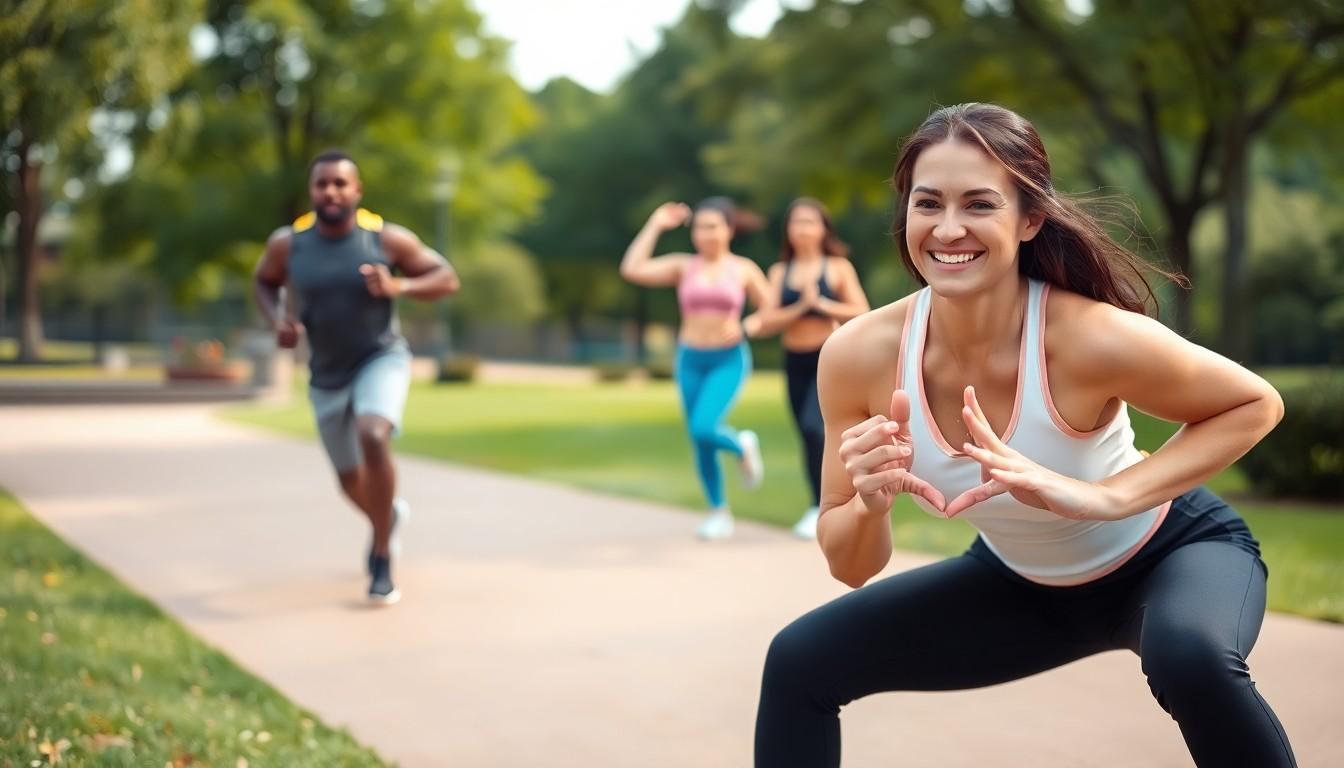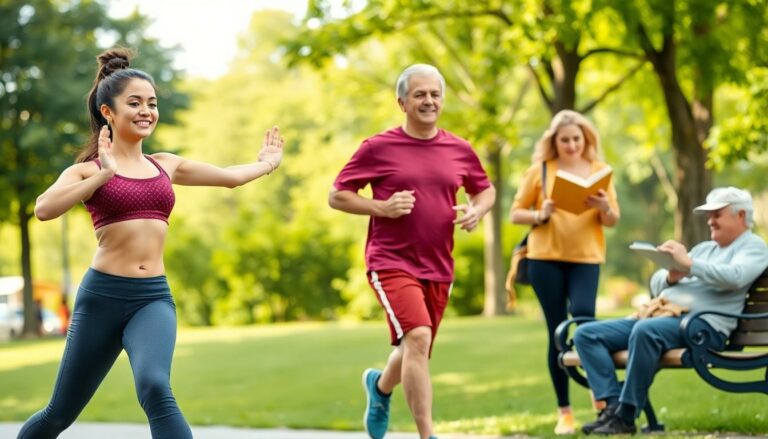Physical Health Images: Unlocking Your Journey to Wellness and Motivation

In a world where a picture is worth a thousand words, physical health images are the unsung heroes of wellness. They don’t just capture the essence of fitness; they inspire action, motivate change, and sometimes even make kale look appetizing. From the perfect squat to the zen-like yoga pose, these images serve as a visual reminder that health isn’t just a destination; it’s a lifestyle.
Physical Health Images
Physical health images play a crucial role in communicating wellness concepts. They illustrate various fitness activities, emphasizing not just aesthetics but also functional health. Activities represented include lifting weights, running, or participating in group fitness classes. Each image serves to inspire viewers by showcasing attainable health and fitness goals.
Visuals featuring diverse individuals promote inclusiveness in the health narrative. By portraying people of various ages, body types, and ethnicities, these images resonate with wider audiences. This diversity encourages individuals to see themselves pursuing active lifestyles.
Health promotion relies significantly on the emotional connection established through images. Seeing others engaged in energetic activities creates motivation and a desire for change. Images depicting common struggles in fitness journeys also foster relatability, reinforcing that challenges are a shared experience.
Branding within the health and fitness industry often leverages physical health images for engagement. Companies incorporate upbeat visuals in marketing campaigns to attract consumers and communicate lifestyle values. The strategic use of vibrant, energizing photos effectively draws attention and invites participation in fitness programs or healthy eating initiatives.
Research shows that physical health images can positively influence behavior. Exposure to motivating visuals often leads to increased exercise frequency and healthier choices. By aligning lifestyle imagery with personal health aspirations, individuals feel empowered to take actionable steps toward improvement.
Physical health images support a narrative of wellness, motivation, and inclusivity. They drive engagement, foster relatability, and can influence healthier lifestyles. Ultimately, these images represent an ongoing journey of health and fitness, resonating with aspirational goals.
Importance of Physical Health Images

Physical health images play a vital role in shaping perceptions and promoting wellness. They not only inspire individuals but also create a visual narrative around healthy living.
Impact on Public Perception
Visuals significantly influence how audiences perceive health and fitness. Appearing in various media, these images often set standards and expectations about body types and lifestyles. Engaging images featuring diverse individuals foster inclusivity, allowing a broader audience to relate and connect. Research shows that exposure to positive health imagery can enhance motivation, encouraging people to adopt healthier habits. Attention-grabbing visuals also help combat negative stereotypes, creating a more supportive environment for all.
Role in Health Education
Health education benefits immensely from the use of impactful images. Illustrative visuals can simplify complex concepts, aiding comprehension of fitness practices and nutritional guidelines. They bridge gaps in understanding by demonstrating proper techniques in exercises like strength training and cardio. Images depicting healthy eating habits reinforce education by showing colorful meals, making healthy choices more appealing. By highlighting relatable everyday scenarios, imagery empowers individuals to take control of their health journeys and promotes active participation in wellness programs.
Types of Physical Health Images
Physical health images encompass various categories, each serving unique purposes in conveying wellness and motivation. These images encourage active lifestyles and shape perceptions of health.
Clinical Imagery
Clinical imagery focuses on medical visuals to promote understanding of health conditions. These visuals may include anatomical diagrams, diagnostic images, or photographs from medical settings. Such images often aim to educate patients about specific health issues, treatment options, or preventative measures. Clear illustrations of organs or illnesses facilitate comprehension. Professionals utilize clinical imagery to reinforce the importance of regular check-ups and healthy habits.
Lifestyle and Fitness Imagery
Lifestyle and fitness imagery captures everyday wellness activities that inspire individuals. Various images depict people engaging in exercises such as jogging, cycling, and yoga. These visuals highlight the emotional aspects of fitness and self-care, showing the joy of movement. Dynamic scenes resonate with audiences and motivate them to adopt healthier routines. Moreover, imagery featuring diverse participants promotes inclusivity, encouraging a broader range of individuals to envision their own fitness journeys.
Health Campaign Graphics
Health campaign graphics operate as key elements in public health messaging. These visuals, often seen in advertisements, posters, and social media, aim to disseminate information efficiently. Vibrant graphics featuring statistics or slogans play critical roles in promoting initiatives such as vaccination drives or healthy eating campaigns. Effective health campaign graphics capture attention and communicate essential messages. Research shows that compelling visuals significantly enhance public engagement, motivating individuals to participate in health-promoting activities.
Analysis of Physical Health Images
Physical health images play a crucial role in conveying wellness narratives. Their effectiveness depends greatly on the ethical standards and representation they embody.
Ethical Considerations
Ethics in physical health imagery encompasses the importance of accurate representations. Images often influence public perceptions of fitness and wellness, making it essential to avoid promoting unrealistic body standards. Ethical guidelines must prevent the use of photoshopped visuals that mislead audiences about health. Transparency about image editing should be a priority in health communications. Moreover, companies should consider the impact of health images on body image issues, ensuring they promote positive self-image for all individuals.
Representation and Diversity
Diverse representation in physical health imagery is vital for audience engagement. Visuals showing varied body types, ages, and ethnic backgrounds resonate with a broader audience. This inclusivity encourages more individuals to engage in active lifestyles, knowing they see themselves reflected in these images. Successful campaigns often showcase real people, highlighting authentic fitness journeys and daily activities. Representation fosters a sense of belonging within fitness communities, making wellness pursuits accessible to everyone.
Making Healthy Living More Accessible and Appealing
Physical health images play a vital role in shaping perceptions of wellness and encouraging healthier lifestyles. By showcasing diverse individuals engaged in various fitness activities, these visuals foster a sense of inclusivity and relatability. They not only motivate viewers but also empower them to embark on their own health journeys.
The ethical considerations surrounding these images emphasize the importance of authenticity and accurate representation. By promoting realistic body standards and diverse representations, the health and fitness industry can create a supportive environment for all. Ultimately, the impact of physical health images extends beyond aesthetics; they inspire action and drive engagement in wellness initiatives, making healthy living more accessible and appealing.



